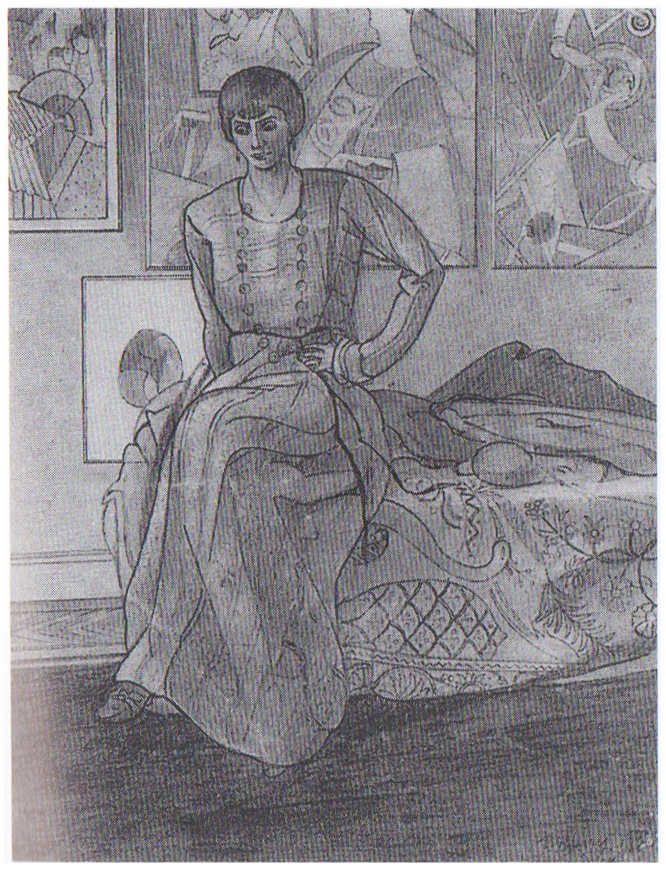THE SILENCE OF 1918
So here is Gleizes, celebrating jazz, which he does not particularly like; and the streets of New York, to which is attitude is at the very least ambiguous. He is in a state of despair over the continuation of the war. He has abandoned a long, serious and apparently quite successful research into the possibilities of portraiture. He is still celebrating the circus, but does not himself find it very interesting: Mme Gleizes tells us of only two visits to the circus, once in Paris in 1914 and once in New York in 1916. (15) And he is closely connected with two men whose ideas and sympathies are as far removed as possible from his own.
(15) Angelica Rudenstine: The Guggenheim Museum Collection: Paintings, 1880-1945, Vol 1, Solomon R. Guggenheim Museum, New York, 1976, p.160.
The period ends in a mystery – the mystery of the year 1918. Gleizes' life seems in this year to have settled down. Mme Gleizes tells us that they were living in Pelham, a quiet rural area outside New York. They do not seem to have travelled. And yet the Catalogue Raisonné gives only one work dating from 1918, a wholly conventional pencil drawing. Nor does he seem to have done much writing. He published an article on the Abbaye de Créteil in October but this was largely taken from L'art dans l'évolution générale. Daniel Robbins says that L'art dans l'évolution générale was written between 1917 and 1919 and it is tempting to think it might have been largely written in 1918, the more so because it is a work that, unlike the poems and prose-poems, lies in the mainstream of his later thinking; and it ends with the proposal for the formation of an artists' union which Gleizes presented when he returned to Paris in 1919. But the book is dated at the end, 'January 1917', and Mme Gleizes confirms that that was when he finished it, which suggests it may have been largely written during the long sea voyages between New York and Barcelona in 1916. (16)
(16) Robbins: Formation and Maturity, p.209. Juliette Roche-Gleizes Mémoires - En attendant la victoire (En attendant la victoire is one of the subtitles for L'Art dans l'évolution générale).
At any rate this book, weighty, serious and sensible and in this resembling most of Gleizes' later writings, may be taken as evidence supporting our second thesis, our 'antithesis' – that during this whole period Gleizes is quite calm and is simply enjoying a certain mastery of the means he has already developed; that all the turbulence of the time – friendship with Cocteau, war, marriage with Juliette Roche, move to America, relations with Duchamp and Picabia – is merely external and barely touches what is essential in his painting; that the fact that he is not particularly interested in the subjects he is painting is of little importance since the subject is only a pretext for the exploration of means whose end is purely pictorial – the 'dynamisme plastique' which he evoked in Du "Cubisme" in 1911 and in Le Cubisme et la Tradition in 1913.
Which poses the question: what are those means? And how do they differ from the means he is seeking in 1920 when he seems to want to start again as from zero. Which again poses the question of the silence of 1918. And of why, after his return to Paris, he was so overwhelmed by the criticisms of Jean Metzinger that he thought of destroying all his New York work. (17) And how does that square with the third of my hypotheses, my 'synthesis', that this was indeed a period of very radical evolution, full of possibilities for the future?
(17) According to Mme Gleizes, quoted in Alibert: Gleizes-biographie, p.108 (fn). Gleizes discusses his conversations with Metzinger in Souvenirs - Retour à la France, 1919-1926, p.8 of the unpublished ms.

This pencil drawing - 'Portrait de Mme Fleischer' - is the only work attributed to 1918 in the Catalogue Raisonné. Curiously enough Gleizes used it as the basis for an ambitious, large scale painting done in 1937-8.